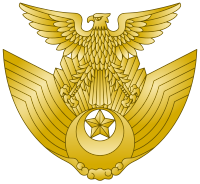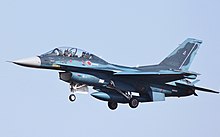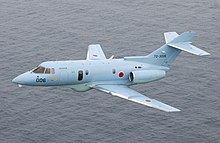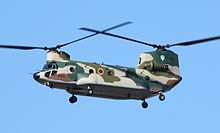Japan Air Self-Defense Force
| Japan Air Self-Defense Force | |
|---|---|
| |
 Emblem of the Air Self-Defense Force | |
| Founded | 1 July 1954[1] |
| Country | |
| Type | Air force Space force |
| Role | |
| Size |
|
| Part of | Japan Self-Defense Forces |
| Headquarters | Ichigaya, Shinjuku, Tokyo |
| Motto(s) | "Key to Defense, Ready Anytime!" |
| Website | www |
| Commanders | |
| Commander-in-Chief | Prime Minister Shigeru Ishiba |
| Minister of Defense | Gen Nakatani |
| Chief of Staff, Joint Staff | General Yoshihide Yoshida |
| Chief of Staff, Air Self-Defense Force | General Hiroaki Uchikura |
| Insignia | |
| Roundel |   |
| Flag |  |
| Aircraft flown | |
| Electronic warfare | E-767, EC-1, E-2C/D, YS-11EA/EB |
| Fighter | F-15J/DJ, F-2A/B, F-35A/B |
| Helicopter | UH-60J, CH-47J (LR) |
| Trainer | T-3, T-7, T-400, T-4 |
| Transport | C-1, C-2, C-130H, Hawker 800, Gulfstream IV, Boeing 777 |
| Tanker | KC-767, KC-130 |
The Japan Air Self-Defense Force (Japanese: 航空自衛隊, Hepburn: Kōkū Jieitai), JASDF (空自, Kūji), also referred to as the Japanese Air Force,[2] is the air and space branch of the Japan Self-Defense Forces, responsible for the defense of Japanese airspace, other air and space operations, cyberwarfare and electronic warfare.[3] The JASDF carries out combat air patrols around Japan, while also maintaining a network of ground and air early-warning radar systems. The branch also has an aerobatic team known as Blue Impulse and has provided air transport in UN peacekeeping missions.
The JASDF had an estimated 49,913 personnel as of 2018, and as of 2023 operates about 712 aircraft, approximately 321 of them being fighter aircraft.[4]
The service will be renamed in 2027 to the Japan Air and Space Self-Defense Force (航空宇宙自衛隊, Kōkū Uchū Jieitai), in recognition of the increasing importance of the space domain.[5]
History
[edit]
Japan did not have a separate air force before and during World War II. Aviation operations were carried out by the Imperial Japanese Army Air Service and the Imperial Japanese Navy Air Service (Kōkūtai). Following defeat in World War II, the Imperial Japanese Army and Navy (including their respective Air Services) were disbanded in 1945.[citation needed]
Under the supervision of the United States occupation authorities, a pacifist Japanese government was appointed in place of the militaristic governments that administered the Empire of Japan during the war.[citation needed] The new government drafted a postwar constitution. While the primary intent of this endeavor was to place the country's political structure on a firmly democratic footing, the constitution endorsed by the United States and ratified by the Diet of Japan in 1947 also contained Article 9 which strictly prohibited Japan from having a regular military.[citation needed]
The U.S. occupation formally ended in 1952, although large American garrison remained in Japan to defend the country. The victory of the Chinese Communist Party in the Chinese Civil War and the onset of the Korean War led the Americans to reconsider what role the Japanese could be expected to play in, at the very least, defending their own home islands against growing Chinese, Soviet and North Korean power in the region. Under U.S. guidance, on 1 July 1954 the National Security Board was reorganized as the Defense Agency, and the National Security Force was reorganized afterwards as the Japan Ground Self-Defense Force (de facto post-war Japanese Army), the Coastal Safety Force was reorganized as the Japan Maritime Self-Defense Force (de facto post-war Japanese Navy) and the Japan Air Self-Defense Force (de facto post-war Japanese Air Force) was established as a new branch of JSDF. General Keizō Hayashi was appointed as the first Chairman of Joint Staff Council—professional head of the three branches. The enabling legislation for this was the 1954 Self-Defense Forces Act (Act No. 165 of 1954).[6][7]
The Far East Air Force, U.S. Air Force, announced on 6 January 1955, that 85 aircraft would be turned over to the fledgling Japanese air force on about 15 January, the first equipment of the new force.[8]
The JASDF Air Defense Command (Japan) Headquarters was relocated from Fuchu Air Base to Yokota Air Base on March 26, 2012. The relocation is due to the 2002 Defense Policy Review Initiative. The purpose is to strengthen the U.S.-Japan Security Alliance. The ADC Headquarters does command and control operations to defend Japanese airspace.[citation needed]
Until 2015, women were banned from becoming fighter jet and reconnaissance aircraft pilots. The first female pilot of an F-15 joined the ranks, along with three other female pilots currently in training, in 2018.[9]
Since 2008, the number of scrambles to intercept Chinese aircraft has increased rapidly. In 2010 there were scrambles against 31 Chinese aircraft and 193 Russian aircraft. In 2018 scrambles increased to against 638 Chinese aircraft and against 343 Russian aircraft. Chinese aircraft flight paths are mostly in the East China Sea, around the Ryukyu Islands and through the Korea Strait. Russia frequently conducts flights orbiting Japan with military aircraft.[10]
The Ministry of Defense reported in fiscal 2018 that there were 999 scrambles by JASDF jets against mainly Chinese and Russian unidentified aircraft. That is the second highest amount of scrambles by the JASDF since 1958. 638 (64%) were Chinese aircraft and 343 (34%) were Russian aircraft. On June 20, 2019, two Russian bombers (Tupolev Tu-95) violated Japanese airspace twice on the same day.[11]
The Diet of Japan approved the modification of the ships of the Izumo-class to operate STOVL aircraft and in 2019 ordered 42 STOVL Lockheed Martin F-35 Lightning IIs.[12] The US Marines will operate their own STOVL F-35s from the Izumo-class in cooperation with the ship's crew to build up a Japanese capability to operate this type. The current plan is for the Japan Air Self-Defense Force to operate the STOVL F-35B from land bases once delivered.[13]
As of 2020, the JASDF is under increasing pressure to intercept warplanes from China's People's Liberation Army Air Force (PLAAF) close to entering its air space. As of the last fiscal year ending in March 2020, the JASDF scrambled aircraft a record 947 times to intercept PLAAF warplanes. This has resulted in heavy wear and tear on their F-15J fighter aircraft,[14] due to this, as of 2021, the JASDF intercepts fewer PLAAF warplane approaches and has deployed F-35 fighter jets to supplement the F-15J fighter jets in this role.[15][16]
On 17 March 2021, the Mitsubishi F-4EJ Phantom II was retired after 50 years of service with the JASDF, being replaced by the F-35A.[17]
During the 9 months of fiscal year 2021, JASDF fighters scrambled against 785 inbound flights.[18] Chinese aircraft were intercepted 571 times (70%), and 199 Russian aircraft.[18] The majority of the Chinese aircraft flew over Okinawa prefecture.[18]
On 22 October 2023, the JASDF conducted its first-ever trilateral exercise with the South Korean and United States air forces near the Korean Peninsula.[19]
The JASDF's Mitsubishi F-2 fighters are slated to be replaced by a future sixth-generation stealth fighter developed under the Global Combat Air Programme (GCAP). This aircraft would be designed by a joint venture set-up in mid-2025 with manufacturing and assembly being subcontracted to Britain's BAE Systems, Italy's Leonardo, and Japan's Mitsubishi Heavy Industries.[20]
A trilateral organisation called the GCAP International Government Organization (GIGO) would oversee the entire project; it would be headquartered in the UK and led by former Japanese Vice Minister of Defense Masami Oka.[21] The fighter is slated to be deployed by 2035 and would be a crewed platform which would possibly be capable of directing other autonomous aircraft.[22][23]
Organization
[edit]
Major units of the JASDF are the Air Defense Command, Air Support Command, Air Training Command, Air Development and Test Command, and Air Materiel Command. The Air Support Command is responsible for direct support of operational forces in rescue, transportation, control, weather monitoring and inspection. The Air Training Command is responsible for basic flying and technical training. The Air Development and Test Command, in addition to overseeing equipment research and development, is also responsible for research and development in such areas as flight medicine. On May 19, 2020, the JASDF officially inaugurated its Space Operation Squadron.[24]

The Air Defense Command has northern, central, and western regional headquarters located at Misawa, Iruma, and Kasuga, respectively and the Southwestern Composite Air Division based at Naha, Okinawa Prefecture. All four regional headquarters control surface-to-air missile units of both the JASDF and the JGSDF located in their respective areas.
- Prime Minister of Japan
- Minister of Defense
- JASDF Chief of Staff / Air Staff Office
 Air Defense Command: Yokota, Fussa, Tokyo
Air Defense Command: Yokota, Fussa, Tokyo
- Northern Air Defense Force: Misawa, Aomori
- 2nd Air Wing (Chitose Air Base: 201SQ, F-15J/DJ, T-4; 203SQ, F-15J/DJ, T-4)
- 3rd Air Wing (Misawa Air Base: 301SQ, F-35A, T-4; 302SQ, F-35A, T-4)
- Northern Air Command Support Flight, (Misawa, T-4)
- Northern Aircraft Control & Warning Wing
- Northern Air Defense Missile Group (9th, 10th, 11th, 20th, 21st, 22nd, 23rd and 24th Air Defense Missile Squadron)
- Central Air Defense Force: Iruma, Saitama
- 6th Air Wing (Komatsu Air Base: 303SQ, F-15J/DJ, T-4; 306SQ, F-15J/DJ, T-4)
- 7th Air Wing (Hyakuri Air Base: 3SQ, F-2A/B T-4)
- Central Air Command Support Squadron (Iruma Air Base T-4, U-4)
- Central Aircraft Control & Warning Wing
- Central Air Defense Missile Group (1st, 2nd, 3rd, 4th, 12th, 13th, 14th and 15th Air Defense Missile Squadron)
- Iwo Jima Air Base Group
- Western Air Defense Force: Kasuga, Fukuoka
- 5th Air Wing (Nyutabaru Air Base: 305SQ, F-15J/DJ, T-4)
- 8th Air Wing (Tsuiki Air Base: 6SQ, F-2A/B, T-4; 8SQ, F-2A/B, T-4)
- Western Air Command Support Squadron, (Kasuga, T-4)

F-2B - Western Aircraft Control & Warning Wing
- Western Air Defense Missile Group (5th, 6th, 7th, and 8th Air defense Missile Squadron)
- Southwestern Air Defense Force: Naha, Okinawa
- 9th Air Wing (Naha Air Base: 204SQ, F-15J/DJ, T-4; 304SQ, F-15J/DJ, T-4
- Southwestern Air Command Support Squadron, T-4)
- Southwestern Aircraft Control & Warning Wing
- Southwestern Air Defense Missile Group (16th, 17th, 18th and 19th Air Defense Missile Squadron)
- Airborne Early Warning and Control Wing: Hamamatsu Air Base )
- Air Tactics Development Wing (Yokota Air Base)
- Tactical Fighter Training Group: Komatsu Air Base (F-15DJ/J, T-4)
- Electronic Warfare Squadron Iruma Air Base (EC-1, YS-11EB)
- Electronic Intelligence Squadron Iruma Air Base (YS-11EB)
- Air Rescue Wing
- Detachments: Chitose, Matsushima, Ashiya, Akita, Hyakuri, Nyutabaru, Niigata, Hamamatsu, Naha, Komatsu, Komaki (Training Squadron) (UH-60J, U-125A)
- Helicopter Airlift Squadrons: Iruma (CH-47J (LR)), Kasuga (CH-47J (LR)), Misawa (CH-47J (LR)), Naha (CH-47J (LR))
- Air Defense Missile Training Group: Hamamatsu, Chitose
- Northern Air Defense Force: Misawa, Aomori
- Air Support Command: Fuchū Air Base, Tokyo

A U-125A aircraft - 1st Tactical Airlift Group (Komaki Air Base: 401SQ, C-130H, KC-130H; 404SQ, KC-767)
- 2nd Tactical Airlift Group (Iruma Air Base: 402SQ, C-1, U-4)
- 3rd Tactical Airlift Group (Miho Air Base: 403SQ, C-1, C-2; 405SQ, KC-46)
- Air Traffic Control Service Group
- Air Weather Group
- Flight Check Squadron (Iruma Air Base: U-125)
- Special Airlift Group: (701SQ Chitose Air Base: Boeing 777-300ER as Japanese Air Force One)
- Air Training Command: Hamamatsu, Shizuoka
- 1st Air Wing (Hamamatsu Air Base: 31SQ, T-4; 32SQ, T-4, 41SQ, T-400)
- 4th Air Wing (Matsushima Air Field: F-2B; 11SQ, T-4 Blue Impulse 21SQ)
- 11th Flying Training Wing (Shizuhama Air Base: 1SQ, T-7; 2SQ, T-7)
- 12th Flight Training Wing (Hofu kita Air Base: 1SQ, T-7; 2SQ, T-7)
- 13th Flight Training Wing (Ashiya Air Base: 1SQ, T-4; 2SQ, T-4)
- Fighter Training Group (Nyutabaru Air Base: 23SQ (Ex-202SQ), F-15DJ, T-4)
- 1st, 2nd, 3rd, 4th & 5th Technical School
- Air Basic Training Wing
- Air Training Aids Group
- Air Officer Candidate School
- Air Development and Test Command: Iruma Air Base, Saitama
- Air Development and Test Wing (Gifu Air Base: F-15J/DJ, F-2A/B, C-1FTB, C-2, T-7, T-4)
- Electronics Development and Test Group
- Aeromedical Laboratory
- Air Material Command: Jujou, Tokyo
- 1st, 2nd, 3rd & 4th Air Depot
- Air Staff College
- Air Communications and Systems Wing
- Aerosafety Service Group
- Central Air Base Group
- Space Operations Squadron
- JASDF Chief of Staff / Air Staff Office
- Minister of Defense
Ranks
[edit]Commissioned officer ranks
[edit]The rank insignia of commissioned officers.
| Rank group | General / flag officers | Senior officers | Junior officers | |||||||||||||||||||||
|---|---|---|---|---|---|---|---|---|---|---|---|---|---|---|---|---|---|---|---|---|---|---|---|---|

|

|

|

|

|

|

|

|

|

| |||||||||||||||
| 幕僚長たる空将 Bakuryōchō-taru-kūshō |
空将 Kūshō |
空将補 Kūshō-ho |
1等空佐 Ittō kūsa |
2等空佐 Nitō kūsa |
3等空佐 Santō kūsa |
1等空尉 Ittō kūi |
2等空尉 Nitō kūi |
3等空尉 Santō kūi |
准空尉 Jun kūi | |||||||||||||||
Other ranks
[edit]The rank insignia of non-commissioned officers and enlisted personnel.
| Rank group | Senior NCOs | Junior NCOs | Enlisted | |||||||||||||||||||||||||||||||||
|---|---|---|---|---|---|---|---|---|---|---|---|---|---|---|---|---|---|---|---|---|---|---|---|---|---|---|---|---|---|---|---|---|---|---|---|---|

|

|

|

|

|

|

|

| |||||||||||||||||||||||||||||
| 空曹長 Kūsōchō |
1等空曹 Ittō kūsō |
2等空曹 Nitō kūsō |
3等空曹 Santō kūsō |
空士長 Kūshichō |
1等空士 Ittō kūshi |
2等空士 Nitō kūshi |
自衛官候補生 Jieikan kōhosei | |||||||||||||||||||||||||||||
Equipment
[edit]The JASDF maintains an integrated network of radar installations and air defense direction centers throughout the country known as the Basic Air Defense Ground Environment. In the late 1980s, the system was modernized and augmented with E-2C Hawkeye airborne early warning aircraft. The nation relies on fighter-interceptor aircraft and surface-to-air missiles to intercept hostile aircraft. Both of these systems were improved from the beginning of the late 1980s. Outmoded aircraft were replaced in the early 1990s with more sophisticated models, and Nike-J missiles have been replaced with the modern Patriot PAC-2 and PAC-3 system and M167 VADS.[26][27] The JASDF also provides air support for ground and sea operations of the JGSDF and the JMSDF and air defense for bases of all the forces. Base defenses were upgraded in the late 1980s with new surface-to-air missiles, modern antiaircraft artillery and new fixed and mobile aircraft shelters.
Aircraft
[edit]



Future aircraft
[edit]Japan has unveiled a plan to enhance its future military equipment, focusing on acquiring additional RC-2 aircraft for command, control, and signal intelligence missions. The plan also includes developing a stand-off electronic warfare aircraft to boost electromagnetic warfare and network capabilities. Additionally, Japan aims to strengthen its unmanned aircraft fleet for intelligence gathering and combat missions.[36]
Japan plans to order 1 RC-2 aircraft with the 2024 budget.[37]
Japan plans to order 4 C-2 SOJ electronic warfare aircraft to replace the EC-1 fleet.[37]
Detailed F-35 orders
[edit]| Fiscal year | Budget
(¥ billion) |
F-35 yearly procurement | Notes | |
| F-35A | F-35B | |||
| Target total | – | 105 | 42 | 147 planned[38] |
| 2025 | ¥ 185.70 | 8 | 3 | [39] |
| 2024 | ¥ 112.00 | 8 | – | [40] |
| ¥ 128.20 | – | 7 | [40] | |
| 2023 | ¥ 106.90 | 8 | – | [41] |
| ¥ 143.50 | – | 8 | [41] | |
| 2022 | ¥ 76.80 | 8 | – | [42] |
| ¥ 51.00 | – | 4 | [42] | |
| 2021 | ¥ 39.10 | 4 | – | [43] |
| ¥ 25.90 | – | 2 | [44] | |
| 2020 | ¥ 28.10 | 3 | – | [45] |
| ¥ 79.30 | – | 6 | [45] | |
| 2019 | ¥ 68.10 | 6 | – | [46] |
| 2018 | ¥ 78.50 | 6 | – | [47] |
| 2017 | ¥ 88.00 | 6 | – | [48] |
| 2016 | ¥ 108.40 | 6 | – | [49] |
| 2015 | ¥ 103.20 | 6 | – | [50] |
| 2014 | ¥ 63.80 | 4 | – | [51] |
| 2013 | ¥ 29.90 | 2 | – | [52] |
| 2012 | ¥ 39.50 | 4 | – | [53] |
| Total | ¥ 1370.2
(+ ¥ 185.70) |
71
(+ 8) |
27
(+ 3) |
– |
| 98
(+ 11) |
– | |||
Culture and traditions
[edit]JASDF Flag
[edit]The Japan Air Self-Defense Force flag was first adopted in 1955 after the JASDF was created in 1954. It is based on a cap badge made in 1954. The flag is cobalt blue with a gold winged eagle on top of a combined star, the moon, the Hinomaru sun disc and clouds.[54] The latest version of the JASDF flag was re-adopted on 19 March 2001.[55] The JASDF flag is different from the JSDF flag and the JGSDF flag. It is determined by a directive regarding the flags of the JSDF.
Food
[edit]The dish of the JASDF is deep-fried chicken karaage,[56] such as Okinawan-style deep-fried chicken.[56] The JASDF tried to increase its popularity by promoting its fried chicken recipe since 2018.[56] There were competitions between the JMSDF's popular curry.[56]
See also
[edit]References
[edit]- ^ a b "What is JASDF?|ORGANIZATION | [JASDF] Japan Air Self-Defense Force". www.mod.go.jp. Retrieved 20 December 2021.
- ^ Gao, Charlie (19 February 2018). "Japan's Air Force: The Best in Asia?". Archived from the original on 30 May 2018. Retrieved 29 May 2018.
- ^ "Mission". JASDF. Retrieved 15 November 2021.
- ^ Hoyle, Craig, ed. (2023). "World Air Forces 2024". Flight Global. Archived from the original on 5 January 2024. Retrieved 1 December 2023.
- ^ Robson, Seth; Kusumoto, Hana (11 October 2023). "Japan is renaming its air force as threats from above become more 'complex'". Stars and Stripes. Retrieved 12 October 2023.
- ^ Takei, Tomohisa (2008). "Japan Maritime Self Defense Force in the New Maritime Era" (PDF). Hatou. 34: 3. Archived from the original (PDF) on 15 December 2018.
- ^ 武居智久 (2008). 海洋新時代における海上自衛隊 [Japan Maritime Self Defense Force in the New Maritime Era] (PDF). 波涛 (in Japanese). 34. 波涛編集委員会: 5. Archived from the original (PDF) on 15 December 2018.
- ^ "Jap Air Force Will Get 85 U. S. Planes". Pittsburgh Post-Gazette. 28 (137). Pittsburgh, Pennsylvania: Associated Press: 2. 7 January 1955.
- ^ "First Japanese woman to fly fighter jet". BBC News. 24 August 2018. Archived from the original on 24 August 2018. Retrieved 24 August 2018.
- ^ "Airspace Surrounding Japan". Japan Ministry of Defense. 26 August 2018. Archived from the original on 26 August 2018. Retrieved 28 October 2019.
- ^ "Russian bombers violated Japan's airspace twice in one day, defense ministry says". Stars and Stripes. 21 June 2019. Archived from the original on 22 June 2019. Retrieved 23 June 2019.
- ^ Lendon, Brad; Wakatsuki, Yoko (18 December 2018). "Japan to have first aircraft carriers since World War II". CNN. Retrieved 15 November 2021.
- ^ Vavasseur, Xavier (21 August 2019). "USMC to Fly First F-35B from Japan's Izumo-class Aircraft Carriers". Retrieved 15 November 2021.
- ^ Lendon, Brad; Wakatsuki, Yoko (29 July 2020). "Japan's air force faces a 'relentless' burden, imposed by China". CNN. Retrieved 15 November 2021.
- ^ Axe, David (2 April 2021). "Japan is About to Waste Its F-35s Shadowing Chinese Planes". Forbes. Retrieved 15 November 2021.
- ^ "Japan scrambling jets less against China as more F-35 deployment eyed". Kyodo News. 3 March 2021. Retrieved 15 November 2021.
- ^ Cenciotti, David (17 March 2021). "Japan's Last Three F-4EJ Phantoms Have Just Flown For The Last Time". The Aviationist. Retrieved 2 April 2021.
- ^ a b c "Exhausting Japanese Air Force, Chinese, Russian Incursions Forced Tokyo To Scramble Its Fighters Over 700 Times In 9 Months". 27 January 2022. Archived from the original on 8 February 2022.
- ^ "US, ROK, Japan hold first joint aerial drill despite North Korean warnings". NK News. 23 October 2023.
- ^ Martin, Tim (13 December 2024). "GCAP partners form joint venture to deliver next-gen fighter for UK, Japan and Italy". Breaking Defense. Retrieved 24 December 2024.
- ^ Bernacchi, Giulia (23 October 2024). "Japan, UK, Italy to Accelerate Development of Next-Gen Fighter Jet". The Defense Post. Retrieved 24 December 2024.
- ^ "Japan, U.K. and Italy to expedite next-generation fighter jet to replace F-2s and Eurofighter Typhoons | The Asahi Shimbun: Breaking News, Japan News and Analysis". The Asahi Shimbun. Archived from the original on 26 November 2024. Retrieved 24 December 2024.
- ^ "Unlocking Sixth-Gen Air Power: Inside the Military Capability for GCAP". rusi.orghttps. Retrieved 24 December 2024.
- ^ "Japan sets up its first 'Space Operations Squadron'". Jane's. 18 May 2020. Retrieved 20 May 2020.
- ^ a b "自衛官の階級" [Self-Defense Forces rank]. mod.go.jp (in Japanese). Japanese Ministry of Defense. Retrieved 7 June 2021.
- ^ "主要装備 ペトリオット". mod.go.jp (in Japanese). Retrieved 11 February 2022.
- ^ @jasdf_hyakuri (18 March 2019). "皆さんこんにちは!本日はVADSの空包射撃訓練の模様をお伝えします。VADSとは、Vulcan Air Defense Systemの頭文字を取った呼び方です。VADSは射手と分隊長の2人1組で射撃を行います。眼差しから、訓練への真剣さが伝わってきます!" (Tweet) (in Japanese). Retrieved 11 February 2022 – via Twitter.
- ^ a b c d e f g h i j k l m n o p q r s t u v w x y z Hoyle, Craig (2024). "World Air Forces 2025". Flight Global. Retrieved 7 December 2024.
- ^ Kadidal, Akhil (25 October 2023). "Japan signed contract for five additional E-2Ds". Jane's. Retrieved 30 May 2024.
- ^ "Sparkly new Boeing 777s set to wing Japanese officialdom around the globe". The Mainichi. 22 April 2019. Retrieved 20 May 2024.
- ^ a b "U-4" (in Japanese). Retrieved 16 May 2020.
- ^ "U-125". Japan Air Self Defense Force (in Japanese). Retrieved 16 May 2020.
- ^ "Textron delivers first two U-680As to JASDF". Key Aero. 24 April 2020. Retrieved 16 May 2020.
- ^ International Institute for Strategic Studies (February 2024). The Military Balance 2024. London: Routledge. p. 280. ISBN 9781032780047.
- ^ Zaffar, Hanan (18 March 2022). "Japan Receives First of Three RQ-4B Global Hawks From US". The Defense Post. Retrieved 26 March 2022.
- ^ Thomas, Richard (15 July 2024). "Japan reemerges as an Asia-Pacific military power". Army Technology. Retrieved 16 July 2024.
- ^ a b "Overview of FY2025 Budget Request (Page 23 pdf)" (PDF).
- ^ Insinna, Valerie (10 July 2020). "US gives the green light to Japan's $23B F-35 buy". Defense News. Retrieved 27 December 2024.
- ^ "Overview of FY2025 Budget Request (Page 23)" (PDF). Motor-Fan[モーターファン] (in Japanese). 1 September 2024. Retrieved 10 November 2024.
- ^ a b "Overview of the FY2024 Budget (Page 25)" (PDF).
- ^ a b "Overview of FY2023 Budget (Page 23)" (PDF).
- ^ a b "Overview of FY2022 Budget (Page 11)" (PDF).
- ^ "Overview of FY2021 Budget (Page 11)" (PDF).
- ^ "Overview of FY2021 Budget (Page 12)" (PDF).
- ^ a b "Overview of FY2020 Budget (Page 12)" (PDF).
- ^ "Overview of FY2019 Budget (Page 14)" (PDF).
- ^ "Overview of FY2018 Budget (Page 10)" (PDF).
- ^ "Overview of FY2017 Budget (Page 10)" (PDF).
- ^ "Overview of FY2016 Budget (Page 9)" (PDF).
- ^ "Overview of FY2015 Budget (Page 9)" (PDF).
- ^ "Overview of FY2014 Budget (Page 11)" (PDF).
- ^ "Overview of FY2013 Budget (Page 11)" (PDF).
- ^ "Overview of FY2012 Budget (Page 7)" (PDF).
- ^ 自衛隊の旗に関する訓令 [Instructions on the flag of the Self-Defense Forces] (PDF) (Defense Agency Instruction 3) (in Japanese). Japanese Defense Agency. 1972.
- ^ "Air Self Defense Force (Japan)". www.crwflags.com. CRW Flags. Archived from the original on 15 March 2016. Retrieved 26 October 2019.
- ^ a b c d "ASDF hopes its fried chicken can outgun popular curry of MSDF". Asahi. 3 November 2020. Archived from the original on 7 April 2021.




